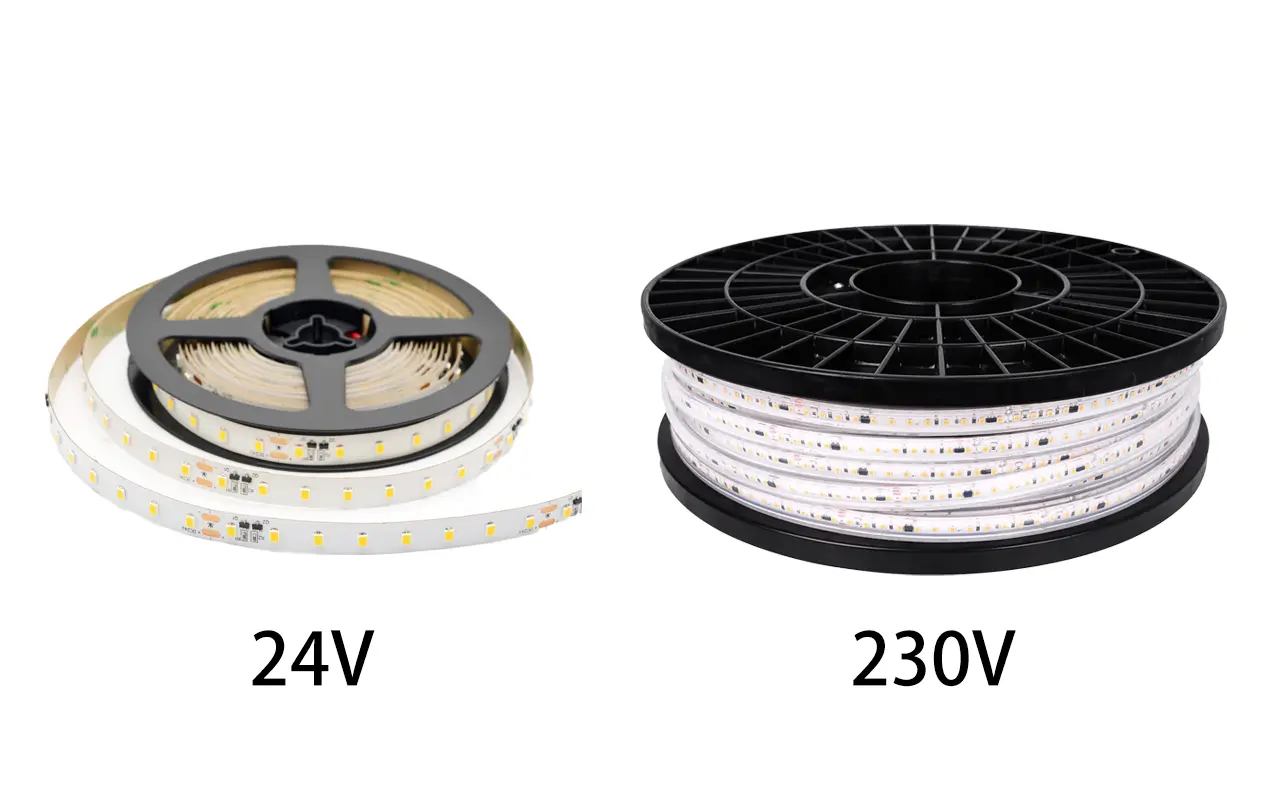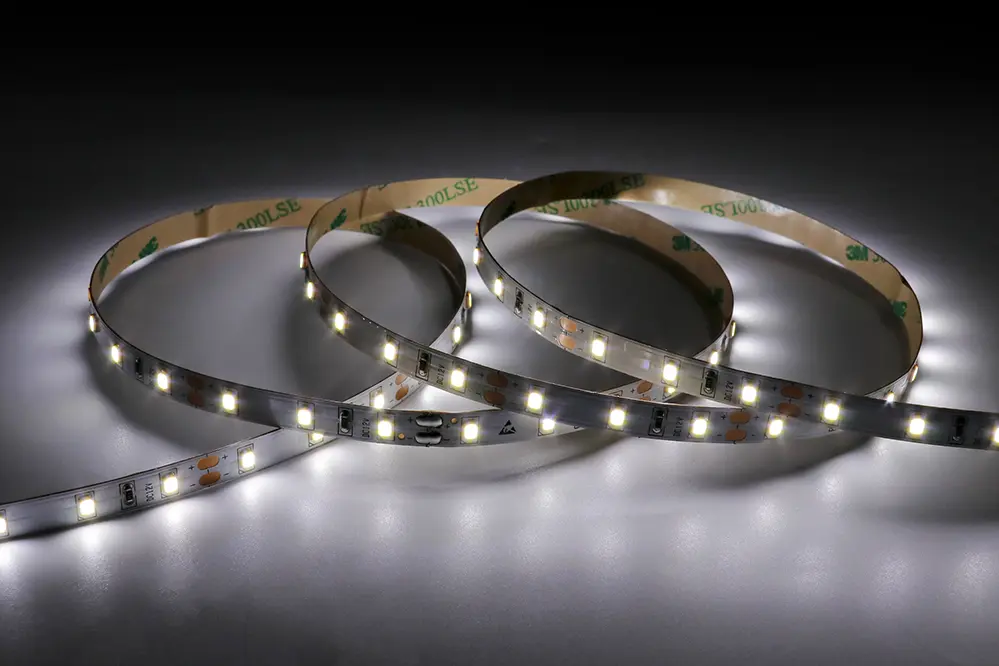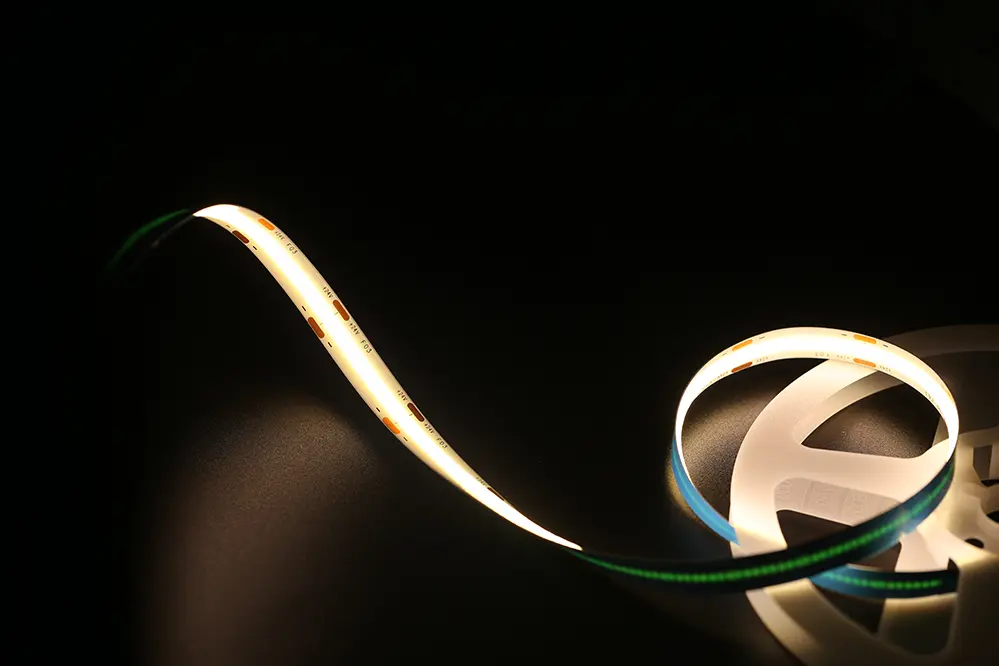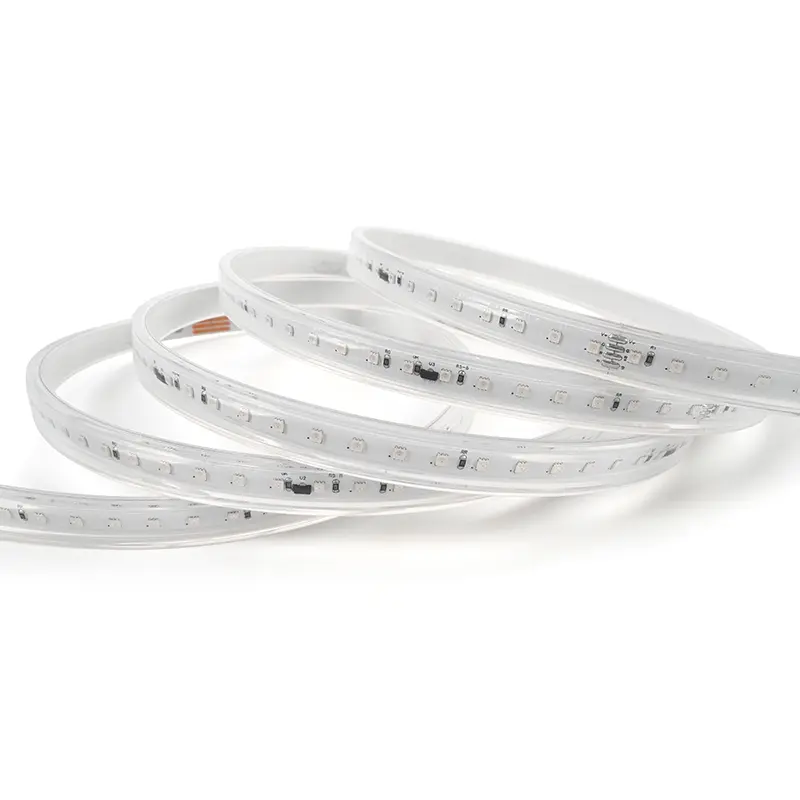In the ever-evolving world of LED lighting, have you ever found yourself pondering the difference between low-voltage and high-voltage LED strips and which one might best illuminate your space? The answer is more complex than one might think, and it hinges on understanding the nuanced needs of your project.
Let me introduce myself—I’m Tom. Since 2005, I’ve been navigating the intricate maze of the LED industry, amassing a wealth of knowledge and experience. My journey has equipped me with insights that can transform the way you think about lighting up any space, from cozy nooks to grandiose halls.
This blog post is your ultimate guide, designed to demystify the distinctions between low-voltage and high-voltage LED strips, highlighting their advantages, applications, and everything in between. Whether you’re an interior design maven, a DIY enthusiast, or a professional looking to up your lighting game, this post has got you covered with actionable insights and expert advice.
So, are you ready to shine a light on the best LED solutions for your projects? Let’s dive right in and illuminate the path to making informed decisions that will brighten up your world!
Introduction: The Evolution of LED Strip Lighting
In the realm of modern lighting solutions, LED strip lights emerge as a beacon of versatility and innovation. These slender bands of light have transformed interiors and exteriors alike, offering a blend of functionality and aesthetic appeal that traditional lighting fixtures struggle to match. With the dawn of LED technology, the palette of lighting design has expanded, introducing a spectrum of colors, brightness levels, and applications unimaginable a few decades ago. Among the plethora of options available, low-voltage and high-voltage LED strips have carved distinct niches, catering to diverse needs and preferences.
As we embark on this illuminative journey, it’s essential to grasp the essence and applications of both low-voltage and high-voltage LED strips. This guide is crafted to shed light on the subtle and stark differences between the two, navigating through their features, benefits, and ideal use cases. Whether you’re a homeowner looking to add a cozy ambiance to your living space, a business owner aiming to enhance the visual appeal of your commercial setting, or a DIY enthusiast keen on exploring the creative potentials of LED lighting, understanding these variations is key.
Low-voltage LED strips, operating at 24 volts or below, are lauded for their safety, energy efficiency, and versatility, making them a popular choice for residential and detailed project applications. On the flip side, high-voltage LED strips, which run on 110 volts or higher, offer the advantage of longer run lengths and simpler installation processes suited for large-scale commercial and industrial projects.
As lighting technology continues to evolve, the distinction between low-voltage and high-voltage LED strips becomes increasingly significant, influencing design choices, installation processes, and, ultimately, the ambiance of the illuminated space. This guide aims to demystify these options, providing you with the knowledge to choose the right type of LED strip light that aligns with your project’s scale, nature, and aesthetic goals. Through a detailed exploration of their characteristics, applications, and comparative analysis, we empower you to make informed decisions, elevating your lighting experience to new heights.
Decoding LED Strip Lights: Low Voltage and High Voltage Defined
In the vibrant world of LED lighting, understanding the difference between low-voltage and high-voltage LED strips is akin to knowing your tools before embarking on a project. Both categories serve distinct purposes, shaped by their electrical design and application environments. Let’s delve deeper into the characteristics of each, helping you navigate through your lighting project with confidence.
Unveiling Low Voltage LED Strips
Imagine weaving a tapestry of light through the intimate spaces of your home, creating layers of warmth and ambiance with precision and safety. This is where low-voltage LED strips come into play. Operating at a mere 12V or 24V, these strips are the quintessential choice for indoor environments where safety and energy efficiency are paramount.
Why choose low voltage? For starters, the reduced power requirement significantly minimizes the risk of electrical hazards, making them an ideal candidate for DIY projects and spaces accessible by children and pets. Their versatility shines through in their ability to be cut into custom lengths, offering unparalleled flexibility in design. Whether it’s under-cabinet lighting in your kitchen, mood lighting behind your TV, or accent lighting along staircases, low-voltage LED strips adapt with ease, enhancing your living spaces without the burden of excessive heat emission.
Moreover, the energy-saving aspect of low-voltage LED strips cannot be overstated. In an era where sustainability is not just a choice but a responsibility, opting for an energy-efficient lighting solution aligns with environmentally conscious living. Coupled with their long lifespan, these LED strips not only reduce your carbon footprint but also offer significant savings on electricity bills over time.
Discovering High Voltage LED Strips
Transitioning from the cozy corners of residential lighting to the expansive arenas of commercial and industrial spaces, high-voltage LED strips step into the spotlight. Designed to operate on 110V or higher, these robust strips cater to the demands of large-scale lighting projects, where length and consistent brightness take precedence.
The ability of high-voltage LED strips to run longer lengths without experiencing a voltage drop is a game-changer for commercial installations. Imagine illuminating the entire length of a shopping mall corridor, an industrial warehouse, or the exterior facade of a building with a single, uninterrupted strip of light. This is the power of high-voltage LED strips – delivering bright, consistent lighting across extensive areas, enhancing visibility and aesthetics alike.
Despite their impressive capabilities, high-voltage LED strips necessitate a thoughtful approach to installation. Given their higher power requirements, it is imperative to adhere to stringent safety protocols during installation. This often means involving professional electricians who can ensure that all electrical codes and standards are met, safeguarding against potential hazards.
However, the trade-offs come with notable advantages. High-voltage LED strips eliminate the need for multiple power supplies or transformers, streamlining the installation process and potentially lowering material and labor costs. While they may offer fewer options for dimming and require careful handling, their durability, and effectiveness in large-scale lighting applications make them an invaluable tool in the commercial lighting arsenal.
In essence, whether you lean towards the subtle, energy-efficient glow of low-voltage LED strips or the powerful, expansive illumination of high-voltage LED strips, understanding their distinct attributes empowers you to make informed decisions. Each brings a unique set of advantages to the table, tailored to suit different lighting needs and environments, enabling you to achieve the desired ambiance and functionality in your lighting projects.
Detailed Comparison: Low Voltage vs. High Voltage LED Strips
Navigating the intricacies of low-voltage versus high-voltage LED strips unveils a spectrum of differences that extend beyond mere voltage specifications. This comprehensive comparison aims to highlight key areas, including safety, cost, installation, packaging, and overall lifespan, assisting you in making an informed decision tailored to your specific needs.
Considérations de sécurité
When it comes to LED strip lighting, the axiom “safety first” cannot be overstated. Low-voltage LED strips, typically operating at 12V or 24V, inherently possess a safety advantage, making them a preferred choice for residential settings and areas accessible by children and pets. The reduced risk of electric shock allows for more versatile applications, including under-cabinet lighting or bedroom ambiance.
Conversely, high-voltage LED strips demand respect for their power. Operating at 110V or higher, these strips necessitate stringent adherence to safety protocols, often requiring the expertise of a professional electrician for installation. While they are perfectly safe once properly installed, the initial setup poses a higher risk and underscores the importance of professional consultation.
Analyzing Costs and Energy Efficiency
From a financial perspective, both low-voltage and high-voltage LED strips present unique cost structures. Initially, the investment may appear similar, but a deeper dive reveals long-term savings with low voltage options due to their superior energy efficiency. These savings are particularly notable in residential settings where lighting remains operational for extended periods.
High-voltage LED strips, while potentially more costly in terms of energy consumption, offer a counterbalance through reduced installation expenses, particularly in commercial or industrial environments. Their ability to cover long distances without the need for multiple power supplies simplifies setup and can lower the overall project cost.
Perspectives d'installation
The ease of installation varies markedly between low and high-voltage LED strips. Low voltage options cater to the DIY enthusiast, offering user-friendly, plug-and-play setups that encourage personal involvement and customization. This accessibility promotes creativity and allows for easy adjustments or expansions to your lighting project.
High voltage strips, while less conducive to DIY approaches, excel in applications requiring extended, continuous runs, such as in commercial or outdoor settings. Although their installation might necessitate professional services, the benefit of seamless lighting across vast spaces often justifies the investment.
Packaging and Durability
Packaging distinctions between low and high-voltage LED strips reflect their intended use and installation environments. Low voltage strips typically arrive in shorter lengths, offering flexibility and precision for intricate design projects. This packaging supports detailed, customizable installations but may require additional connections for more extensive setups.
In contrast, high-voltage LED strips are packaged in longer rolls, catering to the needs of large-area illumination without frequent interruptions for power supplies. This aspect not only affects the ease of installation but also influences their durability and maintenance requirements, with high-voltage strips often designed to endure the rigors of commercial or outdoor use.
Assessing Lifetime and Maintenance
The lifespan and maintenance demands of LED strips are crucial factors for both residential and commercial users. Low-voltage LED strips boast impressive longevity, often exceeding 50,000 hours of use, and require minimal upkeep, making them a cost-effective solution for those seeking durable, long-lasting lighting solutions.
High-voltage LED strips, while robust and suitable for demanding applications, may exhibit a shorter operational life due to the stresses of higher voltage. However, their design for commercial use ensures that they remain a reliable option for those needing extensive, bright illumination across spacious environments.
This detailed exploration into low versus high-voltage LED strips illuminates the nuanced considerations that should guide your selection. Understanding the balance between safety, cost, installation ease, packaging, and lifespan allows for a nuanced approach to choosing the right LED strip lighting for your project, ensuring not only an aesthetically pleasing outcome but also an efficient, safe, and cost-effective lighting solution.
Where to Use: Applications of Low Voltage and High Voltage LED Strips
The versatility of LED strips means there’s a perfect type for nearly any application you can imagine, from cozy home nooks to sprawling industrial complexes. The key to unlocking the potential of these lights lies in understanding where each type excels.
Ideal Use Cases for Low Voltage LED Strips
When it comes to personalizing residential spaces, low-voltage LED strips are unmatched in their versatility and safety. These strips make it simple to transform a room with soft, ambient lighting or highlight specific features of your home. Consider them your go-to tool for under-cabinet lighting in kitchens, where they provide excellent task lighting for countertops without the risk of burns or electrical hazards. They also fit beautifully in living rooms or bedrooms, adding a warm glow to shelving units or headboards, creating an inviting atmosphere that invites relaxation and comfort.
Moreover, their energy efficiency makes them a preferred choice for environmentally conscious homeowners looking to reduce their carbon footprint without sacrificing style or functionality. Whether you’re lighting up a gaming room for an immersive experience or adding a soft backlight to your television for a cinema-like feel, low-voltage LED strips offer a safe, efficient, and stunning solution.
Where High Voltage LED Strips Shine Best
On the other end of the spectrum, high-voltage LED strips are the workhorses of commercial and industrial lighting. Their ability to cover long distances without losing brightness makes them ideal for lighting up large warehouses, manufacturing floors, or outdoor spaces where consistent illumination is key. These strips can withstand the rigors of outdoor use, making them perfect for architectural lighting, where they accentuate the lines and features of buildings, or for perimeter lighting, offering both aesthetic appeal and increased security.
Their robustness and easy installation also make them suitable for large-scale projects such as malls, airports, and parking lots, where complex lighting setups require both durability and efficiency. The upfront investment in high-voltage LED strips pays dividends in reduced maintenance and energy costs over time, proving that they are not just practical but also cost-effective for large enterprises.
Making the Right Choice: Factors to Consider
Deciding between low-voltage and high-voltage LED strips boils down to a few critical considerations. First, assess the scale of your project. Low voltage strips are best for smaller, more intricate installations where safety and precision are paramount. In contrast, high-voltage strips are your ally in large-scale, expansive projects where coverage and simplicity of installation take precedence.
Next, evaluate the installation location. Indoor residential projects often benefit from the safety and energy efficiency of low-voltage strips, while outdoor or commercial spaces can leverage the power and durability of high-voltage options.
Cost is another factor. While both types may have comparable initial expenses, the long-term energy savings of low-voltage LED strips are significant for homeowners. Conversely, commercial projects might find the reduced installation complexity and lower maintenance requirements of high-voltage strips more economically viable.
Lastly, consider the ambiance you wish to create. Low voltage strips offer a range of color temperatures and brightness levels, allowing for a customized atmosphere. High voltage strips, with their bright and consistent light, are ideal for settings where visibility and expansive coverage are critical.
Choosing the right LED strip voltage is about aligning the product’s capabilities with your project’s needs. By considering these factors carefully, you can select a lighting solution that not only meets your aesthetic and functional requirements but also offers safety, efficiency, and cost-effectiveness.
Common Misconceptions Debunked
Navigating the world of LED strip lighting can sometimes feel like a journey through a maze of technical jargon and popular myths. It’s time to shine a light on some of the most common misconceptions to help you make an informed decision with confidence.
One prevalent myth is the notion that the higher the voltage, the brighter the light. This misunderstanding could lead you astray. Brightness in LED strips is not primarily determined by voltage but by the density of LEDs per meter and the quality of the individual LEDs. High-voltage LED strips are designed for long runs and may not necessarily offer brighter illumination compared to their low-voltage counterparts. Instead, consider LED density and chip quality for a true measure of brightness.
Another common misconception is the perceived inherent danger of high-voltage LED strips. While it’s true that high-voltage systems require careful handling and installation to ensure safety, they are not dangerous when installed correctly. Professional installation and adherence to safety guidelines can mitigate risks, making high-voltage LED strips a safe choice for appropriate applications. It’s crucial to understand that both low and high-voltage LED strips can offer safe, efficient lighting solutions when installed and used correctly.
Installation and Maintenance Best Practices
To ensure the longevity and performance of your LED strip lights, following best practices for installation and maintenance is key. Whether you’re working with low-voltage or high-voltage LED strips, adhering to the manufacturer’s guidelines is the first step to success.
For low-voltage LED strips, one of the joys is their relative ease of installation, making them ideal for DIY enthusiasts. However, this doesn’t mean that care shouldn’t be taken. Ensure that you’re using the correct transformer to convert household voltage to the low voltage your strips require. It’s also essential to use quality connectors and to avoid overloading your strips by extending them beyond the manufacturer’s recommended lengths.
When it comes to high-voltage LED strips, professional installation is often recommended. These strips must be carefully handled to ensure that all connections are secure and that the strips are protected from potential damage. Safety measures, such as using conduits for wiring, can prevent accidents and ensure that your lighting installation adheres to local electrical codes.
Maintenance of LED strips involves regular checks to ensure all connections remain secure and that the strips are free from dust and debris, which could affect performance. For dimming capabilities, make sure you’re using the correct type of dimmer for your LED strip voltage type. Low-voltage LED strips often allow for more dimming options, while high-voltage strips may require specific types of dimmers.
Additionally, using compatible accessories, such as aluminum profiles, can not only enhance the aesthetic appeal of your LED strip lighting but also help dissipate heat, extending the life of the LEDs.
By debunking common myths and adhering to best practices for installation and maintenance, you can enjoy the myriad benefits of LED strip lighting in your space, whether you’re lighting up a cozy corner of your home or illuminating a large commercial area. Remember, the key to vibrant and efficient lighting lies in choosing the right products for your needs and treating them with care throughout their lifespan.
FAQs
How do I decide between low-voltage and high-voltage LED strips for my project?
Consider the scale and location of your project. Low-voltage LED strips are ideal for indoor and residential settings due to their safety and versatility. High-voltage LED strips suit large commercial spaces better because of their long run lengths and durability.
Can I install LED strip lights myself, or should I hire a professional?
Low voltage LED strips can often be installed DIY, thanks to their plug-and-play nature. However, for high-voltage LED strips, we recommend professional installation to ensure safety and adherence to electrical standards.
What are the energy efficiency differences between low-voltage and high-voltage LED strips?
Low-voltage LED strips are typically more energy-efficient, making them ideal for reducing long-term energy costs, particularly in residential applications. High voltage strips might use more energy but are designed for efficiency over longer runs in commercial settings.
Quelle est la durée de vie des bandes LED ?
The lifespan of LED strip lights varies by voltage and usage. Generally, low-voltage LED strips have a longer lifespan due to lower energy consumption and heat output. Regular maintenance can further extend their life.
Are high-voltage LED strip lights safe to use outdoors?
Yes, high-voltage LED strips are often designed for outdoor use, offering features like waterproofing and dust resistance. Ensure they are correctly installed and rated for outdoor conditions.
What should I do if my LED strip lights aren’t as bright as I expected?
Check if the LED density and power supply match your brightness expectations. Sometimes, adding more strips or ensuring there’s no voltage drop across long runs can solve brightness issues.
Can I cut LED strip lights to fit my space?
Yes, both low and high-voltage LED strip lights can be cut at designated points. It’s essential to follow the manufacturer’s instructions to avoid damaging the strips.
Do LED strip lights need special dimmers?
Yes, LED strip lights often require specific dimmers to control brightness effectively without causing flicker. Low-voltage strips offer more dimming options, while high-voltage strips may need compatible dimmers.
Are there any special considerations for installing LED strip lights in a kitchen?
For kitchens, consider using low-voltage LED strips for under-cabinet lighting to enhance task lighting while keeping energy costs low. Ensure any high-voltage LED strips are installed safely away from water sources.
How can I ensure my LED strip lights last as long as possible?
Regular maintenance, using compatible accessories, and avoiding overloading the LED strips are key. Also, proper installation should be ensured to prevent any electrical issues that could shorten their lifespan.
Conclusion: Empowering Your Lighting Choices
Understanding the nuances between low-voltage and high-voltage LED strips empowers you to make informed choices that align with your project’s needs. Whether you’re illuminating a cozy corner of your home or a vast commercial space, the right LED strip lighting can enhance aesthetics, improve functionality, and ensure energy efficiency. By considering the factors outlined in this guide, you’re well on your way to selecting the perfect lighting solution.
As you journey through the vibrant world of LED strip lighting, equipped with knowledge of the nuances between low- and high-voltage LED strips, consider Unitop — one of China’s premier manufacturers in the field. Renowned for our exceptional quality Bandes lumineuses LED et Flexible à néon LED, Unitop stands at the forefront of lighting innovation, ready to illuminate your next project with unparalleled brilliance. Should you have any further queries or specific requirements, don’t hesitate to reach out. Embrace the opportunity to elevate your spaces with lighting solutions that reflect Unitop’s commitment to excellence and our deep-rooted expertise in the LED industry. Nous contacter today, and let’s bring your vision to light with the confidence and clarity that only Unitop can offer.

Tom est maintenant le directeur des ventes de Unitop (China) Co., Limited. Il a été dans le Éclairage LED l'industrie depuis 2005. Il est expert en ventes et marketing, et en gestion d'usine. Il aime le bodybuilding, et il est aussi un fan fou d'Apple ! C'est un travailleur acharné qui aime apprendre et essayer de nouvelles choses.
Email : tom@unitopledstrip.com WhatsApp : +86-18680307140












Laisser un commentaire
Rejoindre la discussion?N’hésitez pas à contribuer !